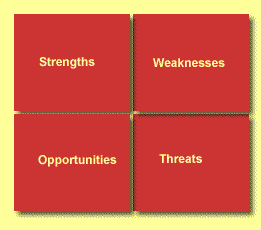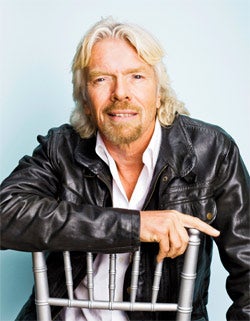by Charles Plant | Oct 3, 2012 | Leaders
 Sam Walton, founder of Wal-Mart was a great believer in looking at strengths, weaknesses, opportunities and threats, SWOT, on a regular basis. So much so that he made it part of their regular Saturday management meetings. In Sam’s own words:
Sam Walton, founder of Wal-Mart was a great believer in looking at strengths, weaknesses, opportunities and threats, SWOT, on a regular basis. So much so that he made it part of their regular Saturday management meetings. In Sam’s own words:
“That Saturday morning meeting is very much about business. Its purpose is to let everyone know what the rest of the company is up to. If we can, we find heroes among our associates and bring them to Bentonville, where we praise them in front of the whole meeting.(Strengths)
“But I don’t like to go to the meeting and hear about just the good things that are happenning. I like to hear what our weaknesses are, where we aren’t doing as well as we should and why. I like to see a problem come up and then hear suggestions as to how it can be corrected. If we decide we’re doing something wrong, and the solution is obvious, we can order changes right then and carry them out over the weekend, while most everybody else in the retail business is off.
“The Saturday morning meeting is where we discuss and debate much of our philosophy and our management strategy (Threats): it is the focal point of all of our communication efforts. It’s where we share ideas (Opportunities) we’ve picked up from various places.”
by Charles Plant | Oct 2, 2012 | Exercises, Management
 Last week I looked at the topic of thinking strategically. One critical dimension of this talent is the ability to see Strengths, Weaknesses, Opportunities and Threats. SWOT. Most of us are good at recognizing strengths and perhaps next at seeing opportunities but we’re usually not very good at finding weaknesses and even worse at seeing threats. If you want to get better at critically examining SWOT in your own organization then you need to be asking yourself these questions:
Last week I looked at the topic of thinking strategically. One critical dimension of this talent is the ability to see Strengths, Weaknesses, Opportunities and Threats. SWOT. Most of us are good at recognizing strengths and perhaps next at seeing opportunities but we’re usually not very good at finding weaknesses and even worse at seeing threats. If you want to get better at critically examining SWOT in your own organization then you need to be asking yourself these questions:
Strengths
For some reason, companies always state that their strength is their people. That’s too easy an answer, a bit self-serving, and in fact it doesn’t really matter to the customer.
- What are customers really buying? Is it Quality, Cost or Speed?
- How are we better at delivering these things to customers than the competition?
Weaknesses
Many organizations don’t like to be self critical. It’s not a good feeling but you better get over the adolescent angst because if you can’t see your weaknesses, your customers can and your competitors will capitalize on them.
- How are our competitors delivering better quality, lower cost of faster service than we are?
- Where is there confusion, conflict, and missed results in our customers minds?
Opportunities
People love new ideas, seeing in them myriad opportunities for new products or services. Ideas are fun but are they real opportunities?
- How can we deliver something to customers that sets a new and vastly different standard in quality, cost, or speed of service?
- Can we disrupt a market or find an entirely new market by reducing quality and cost drastically or increasing both by big margins?
Threats
The threat for any company is that some competitor will come out of left field to dramatically change the existing paradigm.
- What are customers hidden needs that we aren’t meeting that someone else could capitalize on?
- How is the customer changing in ways that we aren’t addressing?
If you’re paying attention, you’ll notice that if you’re thinking strategically, all of these questions are about the customer, not about you. In the end, the only thing that matters in SWOT analysis is the customer.
by Charles Plant | Sep 27, 2012 | Leaders

Thinking Strategically (yesterday’s blog), in more prosaic terms is about seeing the big picture. What’s your big picture? For Richard Branson, it was customer service. He built the Virgin Group, a collection of seemingly unrelated businesses by targeting businesses where things were not being run well by other people.
From his first entrepreneurial venture at the age of 16 to his current big picture idea of Virgin Galactic, Branson has seen niches where others have chosen not to go or as in the case of Virgin Airways, where he was frustrated by current service levels. He founded Virgin Records because no one would produce and release Mike Oldfield’s hypnotic Tubular Bells. He founded Virgin Atlantic because American Airlines canceled a flight to the Virgin Islands.
“There is no point in going into a business unless you can make a radical difference in other people’s lives,” Branson says. “To me, it’s like painting a picture: You have to get all the colors right and all the little nuances right to create the perfect picture, or the perfect company. I know that there’s need for Virgin to come in and attack a marketplace, because I know that I’m frustrated by having to experience bad service in that particular marketplace.” (www.entrepreneur.com)
So frustration leads to big picture leads to another company. If you look at all of his business startups, he was attacking markets where he saw some combination of substandard quality mixed with high cost or slow service. For Branson, the big picture is all about changing the current paradigm of Quality, Cost, and Speed.
by Charles Plant | Sep 26, 2012 | Leadership Development
 Getting ahead in business means thinking strategically. Easy to say but not so easy to do given that many people really don’t know the difference between strategy and tactics. So here goes, an attempt to explain the difference.
Getting ahead in business means thinking strategically. Easy to say but not so easy to do given that many people really don’t know the difference between strategy and tactics. So here goes, an attempt to explain the difference.
When you look in a dictionary (I checked online) it would say something like “A plan of action or policy designed to achieve a major or overall aim.” Not very clear is it? Anything can be called a strategy under that definition. That’s why there are marketing strategies, financial strategies, HR strategies and so on. All of them are designed to achieve an overall aim. If you define your overall aim as earning a profit then you could have a cost reduction strategy too. But are those actually strategies? Nope, to me they’re tactics.
Remember that getting ahead is about thinking strategically so you have to know what to be thinking about at a senior level and what not to be thinking about.
Strategy relates to how you meet customer needs.
Going back to basics, a business is about finding and meeting a set of customer needs. If you want to be more profitable or more successful than you are now then you’ll have to be better meeting those needs than any of your competitors. So strategy first off relates directly as to how you meet customer needs better than your competitors.
When you talk about customer needs, there are only three dimensions within which you can have a conversation. Customers needs can be summarized in three big buckets. They are looking for a certain quality level, at a certain cost and with a certain speed of service. How your product or service fits in those three dimensions of Quality, Cost and Speed is how you’ll be perceived by customers and thus how you’ll stack up against competition.
Customer needs can be defined by Quality, Cost, and Speed
You can compare any two businesses by looking at those three dimensions. Look at MacDonalds versus The Keg for instance. They both serve beef and fries don’t they? But MacDonalds has lower quality, lower cost and faster service. They are strategically differentiated. The Keg’s strategy is to earn more money by selling higher quality at a higher cost with slower service. What matters most to both of these restaurants is how you perceive these three dimensions of their offerings.
To change or improve or fix your business, what you have to do is change, improve or fix one of those three elements of Quality, Cost, and Speed. It all comes back to that.
Thinking Strategically
Thinking Strategically means thinking about and spending time and money on issues that directly relate to Quality Cost and Speed. Furthermore, it means thinking about things that have a big effect on these three items.
by Charles Plant | Sep 21, 2012 | Research
 What? A second blog today? I actually wrote the last one on Wednesday but got distracted and forgot to promote it until today. So much for focus.
What? A second blog today? I actually wrote the last one on Wednesday but got distracted and forgot to promote it until today. So much for focus.
You might have noticed that women are taking over the world. From university enrolment to the professions and now to politics, women are coming to dominate men in almost every field. You might have wondered why. (Or you might not have, but I’ll tell you why anyway.)
It’s because of focus. Men don’t focus as well as women. In order to advance mankind’s understanding of the human condition I have penned this blog so here it is, 5 reasons why men can’t focus.
- The Hunter Instinct – Men are evolutionarily designed to be hunters. From the earliest days of mankind, men were responsible for killing game. To do that requires that men be highly aware of the smallest movement in case it means there is something out there to kill and eat. Nowadays when men are in meetings, they still carry this evolutionary trait and are easily distracted by the smallest things.
- Superior Intelligence – Men are the more intelligent of the sexes as they have so many important things to think about. Who can focus on doing dishes or putting the toilet seat down whene there is world hunger to solve or hockey games to think about? Perhaps men will become more focussed this year as a result of the hockey lockout.
- Emotional Attunement – Men are so emotionally attuned that it hurts. They notice each and every change in emotions, especially in women. With such emotional attunement men are constantly distracted by even the slightest display of emotion. In order to focus, they have had to block these messages out and as a result, they have blocked them so successfully that many men deny having any emotions whatsoever.
- Sex – Yes, sex. Did you know that studies have shown that men think of sex on an average, every 8 seconds. If you’re thinking about sex that often, how could you focus any anything else effectively?
 Sam Walton, founder of Wal-Mart was a great believer in looking at strengths, weaknesses, opportunities and threats, SWOT, on a regular basis. So much so that he made it part of their regular Saturday management meetings. In Sam’s own words:
Sam Walton, founder of Wal-Mart was a great believer in looking at strengths, weaknesses, opportunities and threats, SWOT, on a regular basis. So much so that he made it part of their regular Saturday management meetings. In Sam’s own words:



